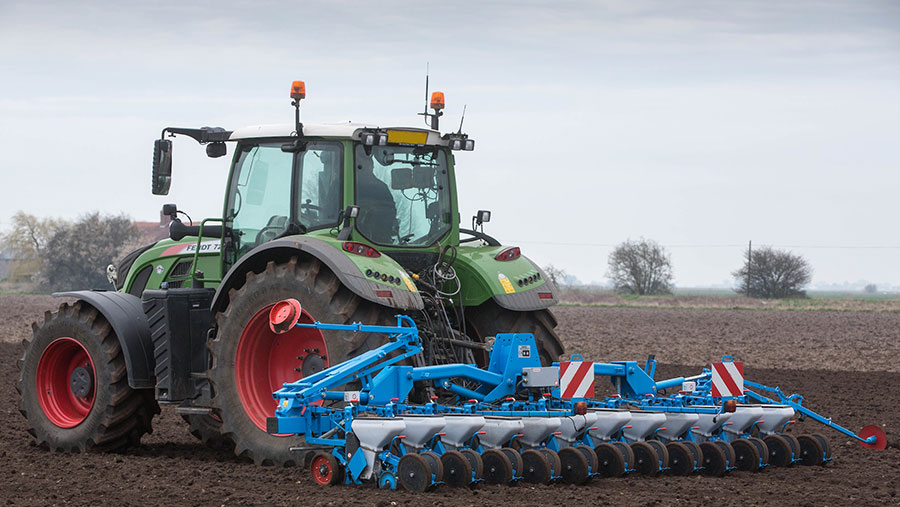What the neonics authorisation means for sugar beet growers
 © Tim Scrivener
© Tim Scrivener Sugar beet seed can be treated with the neonicotinoid dressing Cruiser SB (thiamethoxam) this spring to protect crops against aphid-spread virus yellows under an emergency authorisation.
The temporary derogation comes as the official Rothamsted forecast predicts the likely incidence of virus yellows will exceed this year’s 63% threshold level, with a predicted rate of 67.5%.
Authorisation of the thiamethoxam seed treatment comes as a relief to many beet growers, who have already battled the effects of rising costs, frost-damaged crops and beet moth attacks.
See also: Sustainable Farming Incentive: Two growers weigh up the pros and cons
However, growers using treated seed must follow stringent conditions in accordance with the emergency authorisation.
One of these restricts a number of flowering crops, such as oilseed rape, from being sown for a minimum of 32 months after treated beet was drilled.
Other flowering crops that fall under this category include linseed, mustard, soya beans, peas, beans, buckwheat, clover, phacelia, chicory, radish, vetch, false flax, lucerne, sunflower, borage, sainfoin, niger and lupin
Farmer thoughts
Lincolnshire sugar beet grower and haulier Tom Craven welcomes the derogation and plans to use the seed dressing across half of his 280ha sugar beet area.
However, he is reluctant to use the treated seed in some areas as it prevents oilseed rape from being grown in the rotation for more than two-and-a-half years after.
“Using the seed treatment gives us reassurance our crops are protected from virus yellows, but not being able to grow oilseed rape for 32 months after seems a bit excessive,” he says.
With restricted subsequent crop choice and additional costs associated with dressed seed, Mr Craven largely targets later-lifted fields with the dressed seed, to give crops an extra bit of protection.
Last season, 50% of crops received the neonicotinoid dressing, and the difference in yellowing between treated and untreated crops was clear.
Although Mr Craven admits there was no significant yield difference, later-lifted crops in December and January were severely affected by frost, which could have masked yield variations.
Norfolk
Over in Norfolk, sugar beet grower Robert Scott has not used neonicotinoid seed dressings since the ban in 2018, and this season will be no different for his 175ha beet area.
“Our crop rotations do not allow for a 32-month delay in planting flowering crops. We are farming either completely insecticide free or with severely restricted use as we strive to farm in a more environmentally friendly way,” he says.
Mr Scott notes that virus yellows significantly reduced yields in the first year after the neonicotinoid ban, but since then the damage has been tolerable. He describes drought, beet moth, violet root rot and the recent frosts as bigger yield threats.
Strict conditions of use
Other conditions of use detailed in the emergency authorisation reveal only sugar beet crops contracted with British Sugar are eligible.
Fodder beet, energy beet and red beet are not included.
Furthermore, the drilling rate for treated beet seed must not exceed 115,000 seeds/ha (1.15 units/ha). Higher rates must be made up of untreated seed.
The emergency authorisation is only available for 120 days.
This means treated seed cannot be drilled after 1 June 2023, regardless of unfavourable weather that may delay drilling.
Thiamethoxam seed treatments may not be used on the same field within 46 months, including any potential redrilling.
If growers need to plant sugar beet in the same field within 46 months, they must use non-treated seed.
This is to reduce the risk of soil residues building up that could indirectly expose pollinators to the pesticide.
A herbicide programme recommended by a Basis-qualified professional must also be adopted when using treated seed to minimise the number of flowering weeds in treated beet crops
Foliar insecticides and spill kits
Cruiser SB provides protection against aphids for up to 10 weeks after drilling, reducing the need for further foliar sprays.
However, regardless of whether treated seed was used, growers continue to have the option to employ a foliar spray programme if aphid thresholds are met.
This threshold for foliar insecticide applications is five green wingless aphid per 20 plants up to the 12-leaf stage.
At 12-16 leaves the threshold is one green wingless aphid per plant.
Foliar sprays of one application of either Teppeki or Afinto (flonicamid), and one application of acetamiprid (Insyst) are available.
The exception to this rule is that where treated seed has been used, acetamiprid (Insyst) cannot be the first foliar spray applied.
When using treated seed, growers must have access to a spill kit, which will be sent direct to growers.
All spillages should be cleaned up using the kit provided.
Drill operators are also advised to wear appropriate personal protective equipment such as face mask and gloves.
Machinery should be thoroughly emptied and cleaned before moving non-Cruiser-treated seeds, to avoid contamination.
Field records detailing the use of Cruiser SB-treated seed must be kept for a minimum of three years.

